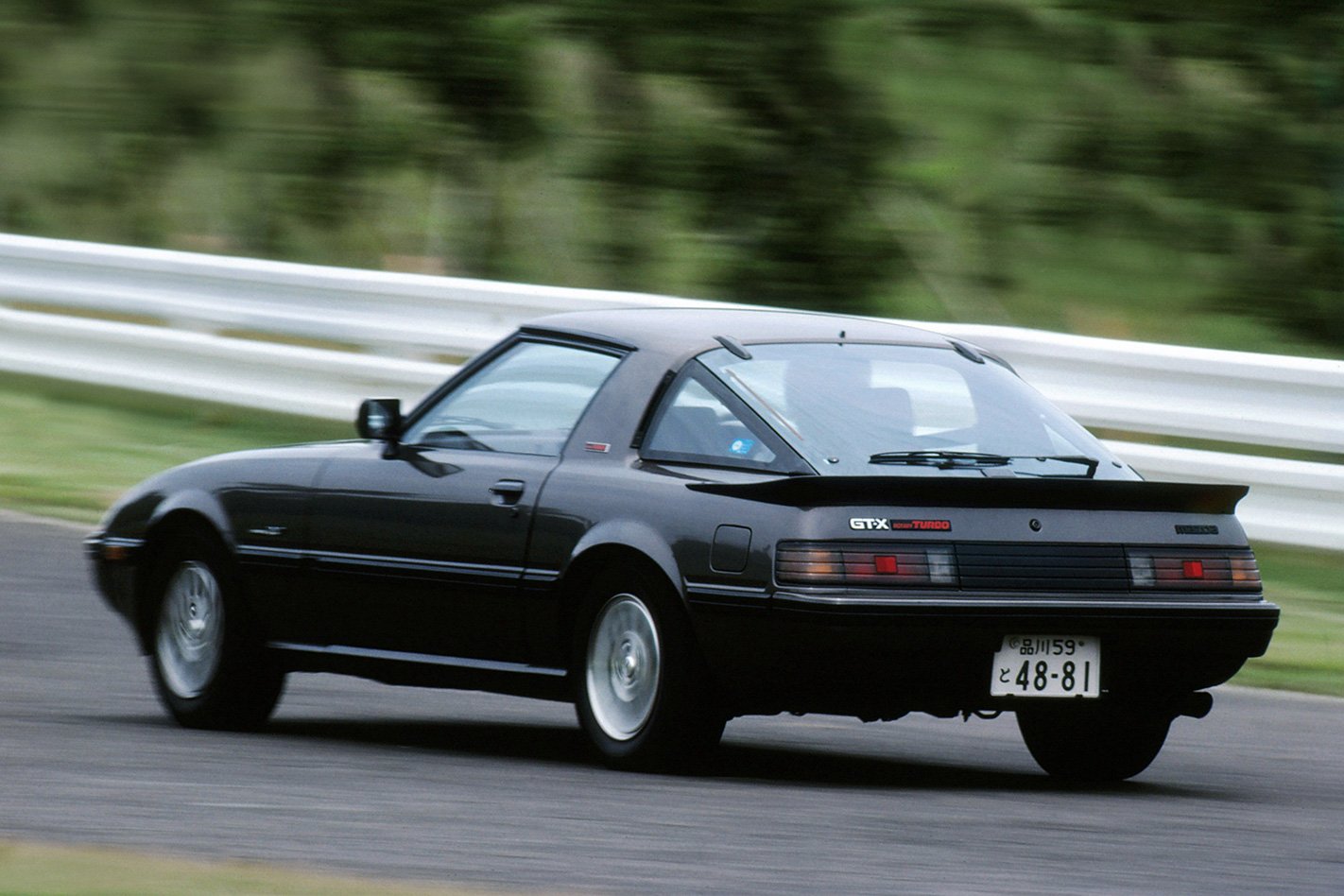THE Mazda RX-7 turns 40 this year and, though the iconic Japanese sportscar hasn’t graced a Mazda showroom floor for 16 years, its legendary status still attracts a cult following both in Australia and around the world.

It’s a story that started in the late 1970s, when Mazda had already cemented itself as an authority in Wankel engines and had rotaries in service under the bonnets of the Cosmo luxury coupe, Luce sedan and even some oddball offerings like the Parkway bus and Roadpacer AP (AKA, the rotary Kingswood), but the company wanted a true athlete to succeed the ageing RX-3 coupe.
That sports star would take the form of a lean and elegant liftback two-seater coupe that arrived in March 1978, wearing the now famous RX-7 nameplate.
First generation: SA22C
The first of three generations, it was the bantamweight rotary engine that was central to the initial RX-7’s success. Not only was its naturally aspirated twin-rotor construction feather light, it was compact too, allowing it to be positioned far back behind the front axle for balanced 50:50 weight distribution.

But the linear, incredibly free-revving power delivery (accompanied by an unmistakable soundtrack) was unlike almost everything else on the road, and it wasn’t long before driving enthusiasts and tuners started to pay attention. Indeed, Mazda thought it necessary to include a rev warning buzzer to alert drivers who didn’t realise the 7000 rpm limit was approaching.
The first-generation SA22 RX-7 produced a modest 77kW, but it was light at 1100kg – and catseye-scrapingly low. The lithe formula adhered to the traditional sportscar mantra of prioritizing driving dynamics over outright muscle, much like the Lotus Elan, or even the RX-7’s distant cousin the ND MX-5.
An update for the series 2 SA22 brought a modest power-up to 85kW, disc brakes at all corners and a mechanical limited-slip differential as standard in some markets, but the final update to series 3 brought fuel injection, pushing the little coupe past the 100kW barrier.
Even early on, Mazda was aware of the inherent problems of the rotary engine, including its high hydrocarbon emissions and low fuel efficiency – the main Achilles heel that would eventually call full time on the Mazda power plant.

An appetite for rotor apex and face seals was another thorn in the side of the Wankel engine, but Mazda persevered with the design, driven by the demand from a staunch group of enthusiasts.
As a final fling, Mazda introduced a special 1985 finale just for Australia, while a turbocharged swansong was another late-life highlight that brought another power hike – but without an intercooler the blower added only 20kW extra. It nevertheless laid the foundation for the RX-7’s turbocharger-dominated future.
Second generation – FC3S
When the RX-7 was reborn as the second-gen FC its displacement remained at 1.3 litres (the original 12A rotary started out with 1.1 litres) and 108kW, but a Turbo II variant was offered in the US with 136kW. The styling made greater leaps, with the RX-7 outgrowing the slim-waisted 1970s bodywork of the SA22C and slipping into a more chamfered design that was somewhat reminiscent of Porsche’s 924.

As well, the former live axle rear suspension which had imparted overtly tail-happy handling in the FC was revised to independent suspension with a dramatic improvement to handling.
Power grew again with the introduction of the Series 5 RX-7 – 119kW for the atmo and 149kW for the turbo. Revised steering sharpened the front end, while a unique set of rear hubs allowed a degree of passive rear steering. The RX-7 was really starting to grow up technologically, but so was its weight.
Once again, Australia was offered a special edition – this time the RX-7 Sports – which was limited to 250 examples and attempted to shed some of the 360kg in additional mass that the FC RX-7 had gained by leaving power steering, electric windows and the rear wiper on the shelf.

Another milestone came in 1988, when the RX-7 convertible arrived with a partially-powered roof and stereo speakers hidden in the seat head rests – a feature still found in the ND MX-5.
Despite the weight gain and growing proportions, the RX-7 was constantly evolving, improving and charming the motoring media and customers alike, and by the time the gen-two was put out to pasture in 1992, the turbo was blasting out 160kW. Not bad for a 1.3-litre.
Nobody knew it at the time, but the third generation would also be the last for the RX-7 badge. However Mazda certainly didn’t ease off the gas for its swansong RX-7. In 1992, the FD blasted in with an absurdly complex sequential twin-turbo system developed in partnership with Hitachi, which started out with 188kW but would turn the taps up to 206kW by the time production ended in 2002.

Staggeringly, the twin-rotor engine still hadn’t grown beyond 1.3 litres which meant the final RX-7 could brag an output of 158kW per litre. That’s more than a Mercedes-AMG A45.
Piloting such a highly strung beast required special care to avoid snapping the tail into sudden oversteer as the second turbo stepped in at 4500 rpm, with a notable boost in power.
Over the course of the final RX-7 iteration, the car evolved through numerous variants including the Spirit R, Type R, Type RZ, Type RB and A-Spec depending on the global region, with three facelifts over its ten-year lifespan.
Among the various special editions throughout the FD’s life, Australia was once again treated to some of the finest. An unapologetically race-honed RX-7 SP arrived in 1995, homologated to compete in the GT Production Car Series and brought circuit-ready equipment including a carbonfibre nose, rear spoiler and larger fuel tank.

A more efficient intercooler, special exhaust and remapped engine control software helped produce a power figure of 204kW, while bigger brakes, larger wheels and Recaro seats completed the package.
The mods clearly worked and the car won the Eastern Creek 12 Hour the year of its introduction and another podium finish at the Targa Tasmania spawned another special edition – which was only offered in Japan, bizarrely.
Legacy
It’s fair to say the motoring community shed a tear when the model made its curtain call in 2002 and, while the news that it would be succeeded by a new RX-8 soothed the wounds, the RX-7 is still celebrated to this day.
The RX-8 kept the spirit of rotary power alive for another 10 years with mad, naturally aspirated revs, but ended the bloodline in 2012 when it bowed out without an heir to the Wankel throne. Could anything rekindle the magic that three generations of RX-7 created?

When the sexy and curvaceous RX Vision made its debut at the Tokyo show in 2015, it sparked hopes that a new model would pick up the rotary baton, and while Mazda has yet to officially confirm a production version of the concept, the trail is far from cold.
The latest intel suggests a new sportscar halo is still very much on the wishlist and that its powertrain will indeed revive rotary power – albeit with electrified hybrid assistance to help rectify the rotary’s eternal bugbear – fuel consumption. It won’t happen soon though – Mazda isn’t in any hurry to bring a new rotary sports car out until sometime in the early 2020s.
When Mazda is ready to talk about the next chapter, it will owe a big debt of thanks to its iconic rotary star and for that we say happy birthday and three braps for the RX-7.






